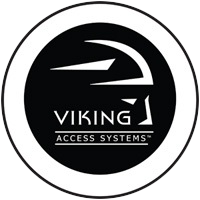Connecting Access Control and Safety devices
This post applies to all
Viking control boards including the 1st gen (GateTor) board.
In relationship to our control board,
all of these different access control devices are simple relays that come in an
assortment of different housings with different purposes. But they all
communicate in the same way to the Viking control board; they create a contact (or
short), across two wires when they want the gate to do something.
In other words,
when you use your radio receiver, photoelectric beam, key pad, etc, its
built-in relay will create a contact, or a bridge, across two of its terminals
when this device is triggered or activated.
With the
example of a radio receiver, the signal it receives from the radio transmitter
is what triggers its relay, creating a contact across its Common and Normally
Open terminals. This contact is what tells the VFlex board to open the gate.
The "Radio" LED will illuminate on the board while this contact is
made.
ü If you connected your device to our VFlex board
properly, the gate will respond as you intended.
û
If you didn't, no
worries! Our control boards are short circuit protected. However, you will need to connect your device properly
Terminology:
Terminal:
This is where you will be connecting wires to the VFlex board.
This is where you will be connecting wires to the VFlex board.
Terminal Block: The green removable blocks, on the VFlex board,
containing multiple terminals. Example:
The "Exit", "Fire" and "Strike" terminals are all
located on the "Open Commands" terminal
block.
Input Terminal: On the VFlex board, any of the terminals which are
labeled for a specific command or "input" (i.e. "Re-Open", "Radio",
"Open", etc.). The N.O. ,
Normally Open, contact from your device is to be connected to an Input
Terminal.
Relay: The component of an access control or safety device
that provides the input, or command, to the VFlex board.
Trigger: This is what will tell the Relay to change state,
creating the bridge between Common and Normally Open. The type of trigger
depends on the device. I.e. the trigger for a radio receiver is the signal from
the transmitter, a Photoelectric Beam is triggered when the beam is interrupted
and a Keypad is triggered when the code is punched in.
“C”: The relay
Common terminal. This is the terminal that will make contact (short or
bridge) to the N.O. terminal when the relay is triggered. Always wire this relay terminal to any
“GND” terminal at the VFlex board.
“N.O.”: The relay Normally Open terminal. This is the terminal that has an open
contact to “C” while the relay is not triggered and a closed contact when the
relay is triggered. Almost
always use this relay terminal and wire it to an “Input Terminal” at the VFlex
board,
“N.C.”: The relay Normally Closed terminal. This is the terminal that has a closed contact to “C”
while the relay is not triggered and an open contact when the relay is
triggered. This terminal is
rarely used when connecting to a Viking control board.
Coil: The component of an access control or safety device
that receives 24VDC power from the Viking control board, used to power the
device.
“+”: The positive power terminal of the coil. Always connect this to any “+28V”
terminal at the VFlex board.
“–”: The negative power terminal of the coil. Always connect this to any “GND”
terminal at the VFlex board.
Now that I know the basics, how do I hook it up?
Well, first you will have to know:
Well, first you will have to know:
1.
Who is the manufacture of this device?
2.
What is the model# of this device?
3.
How do you want the gate to respond to it?
The Who & What and Why you need to know this:
 Tip: You need know what the terminals or
wires, on your device, are designated for. But you threw away the instruction
manual. No worries! By knowing the manufacture and model#, you can easily
Google search for the manual of this device.
Tip: You need know what the terminals or
wires, on your device, are designated for. But you threw away the instruction
manual. No worries! By knowing the manufacture and model#, you can easily
Google search for the manual of this device.
Once
you know which terminal or wire color is designated for + , - , C and N.O., the rest is simple!
As you
probably noticed, there are typically 5 terminals, or wires, on your device.
However, you will only use 4 of them. Three of the four will ALWAYS
connect to the same place on the control board:
+ , or positive, from the device will
ALWAYS connect to a "+28V"
terminal.
NOTE: There are 3
terminals labeled +28V. It does not matter which one you use.
- , or negative, from the device will
ALWAYS connect to a "GND"
terminal.
NOTE: There are many
terminals labeled GND. It does not matter which one you use.
·
Two are used for the device to tell (command) the board
what to do and when to do it..
"C", or Common, from
the device will ALWAYS connect to a "GND"
terminal.
NOTE: There are many
terminals labeled GND. It does not matter which one you use.
"N.O.", or Normally Open, from the device will connect to
an input terminal. (i.e. Exit, Reopen, C. Loop, UL, Radio, etc.). Which input
terminal to use only depends on how you want you want the gate to respond to
your device.
The How:
How do you want the gate to respond
to this device?
The table below describes how the
gate will respond when each of the Input terminals are shorted to a
"GND" terminal.
Tip: You can simulate your device
being triggered, and how the gate will respond, by simply contacting these two
terminals together with a pair of needle nose pliers.






No comments:
Post a Comment